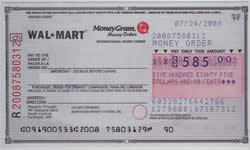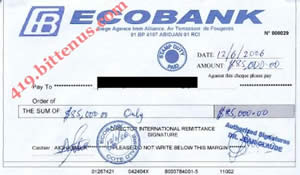Difference between Money Order and Bank Draft
Key Difference: Money Order is a mode of payment that requires the payer to pay a specified amount of money before-hand. This is considered as a safe method of payment as the amount printed is already prepaid. Bank drafts are cheques that are drawn on bank’s funds after it accepts the same amount from the issuer’s account. A bank draft is also known as a cashier’s check. These are guaranteed by a bank. In this method, the payee would issue a cheque from their own bank, which would guarantee the amount of money issued on the draft.
include("ad4th.php"); ?>
 Money Orders and Bank Drafts are a similar mode of payments that require third-party institutions to guarantee the payment. These both methods also ensure that the payer does not have to carry large amounts of sum with them. Money orders can be made by any institution that is approved; however, a bank draft is issued by a bank.
Money Orders and Bank Drafts are a similar mode of payments that require third-party institutions to guarantee the payment. These both methods also ensure that the payer does not have to carry large amounts of sum with them. Money orders can be made by any institution that is approved; however, a bank draft is issued by a bank.
Also see: Difference between salary account and current account
Money Order is a mode of payment that requires the payer to pay a specified amount of money before-hand. This is considered as a safe method of payment as the amount printed is already prepaid. Let’s explain using an example. Let’s assume John wanted to issue a money order for US$ 200 to give it to his friend Tom. He would go to a credited institute that has the power to issue money orders and pay them the US$ 200 plus a fee for the money order. The institution would take the money and issue John a cheque type paper and a receipt. John would then just give the money order to Tom and keep the receipt for his proof. Tom would go to the place that accepts money orders and gives them the money order, which would then give him cash.
include("ad3rd.php"); ?>
Money orders can be issued from certified stores, post offices and even banks. The banks automatically credit the amount from the bank account when creating the money order. Since money order requires that the payer pay beforehand, this is considered as an even safer than a normal cheque. However, money orders are under scrutiny as they can be widely used to launder money. One of the methods to put a limit to this, many governments have issued a limit of how much money can be turned into a money order. However, some banks will allow issuing large sums on the money order as they would deduct it from the account.
Also see: Difference between NEFT and net banking
Money orders were established by a private firm in Great Britain in 1792, but because of the high fees, they were not very successful. After it was sold to another private firm in 1836, who then reduced the fees, it became a popular means of payment method. After this many post offices also started offering money orders.
 Bank drafts are cheques that are drawn on bank’s funds after it accepts the same amount from the issuer’s account. A bank draft is also known as a cashier’s check. These are guaranteed by a bank. In this method, the payee would issue a cheque from their own bank, which would guarantee the amount of money issued on the draft. Bank Draft is also known as cashier's cheque, banker's cheque, bank cheque, official cheque, demand draft, teller's cheque or treasurer's cheque. Let’s use the same example of John and Tom. John would go to his own bank, in which he has an account and issue a bank draft. (Note, that amount should be available in John’s account.) The cashier would check if John has that much amount of money in his account and sign the draft. The bank would then withdraw that amount from John’s account. Once the draft is passed on to Tom, he can then cash it at another bank or deposit it into this account like a normal cheque. Tom’s bank would then take the money from John’s bank directly.
Bank drafts are cheques that are drawn on bank’s funds after it accepts the same amount from the issuer’s account. A bank draft is also known as a cashier’s check. These are guaranteed by a bank. In this method, the payee would issue a cheque from their own bank, which would guarantee the amount of money issued on the draft. Bank Draft is also known as cashier's cheque, banker's cheque, bank cheque, official cheque, demand draft, teller's cheque or treasurer's cheque. Let’s use the same example of John and Tom. John would go to his own bank, in which he has an account and issue a bank draft. (Note, that amount should be available in John’s account.) The cashier would check if John has that much amount of money in his account and sign the draft. The bank would then withdraw that amount from John’s account. Once the draft is passed on to Tom, he can then cash it at another bank or deposit it into this account like a normal cheque. Tom’s bank would then take the money from John’s bank directly.
A bank draft basically transfers the payer responsibility from the payee to his bank. Bank Draft can only be issued from banks where the payer has an account. This is most commonly used in real estate or brokerage transactions. This is also a safe method of payment as the amount is guaranteed by a financial institution. Bank drafts that are deposited are usually cleared the next day, but the customer can ask for a ‘next-day availability’ when depositing the draft in person. One way the banks can safeguard themselves against fraud is by being able to retrieve cleared cheques within one or two weeks if they believe it is fraudulent. However, many people can still be defrauded as the cheques can be converted to instant cash. A Bank Draft can be issued for higher amounts.
The major difference between the two is the amount of limit that can be issued. A money order has a small amount limit (i.e. US$ 1,000 in the US), while the amount in Bank draft can be higher. Money orders are also cheaper compared to bank drafts because of the amount limit and the process the banks have to go through. Money orders are also far easier to obtain rather than bank drafts as it requires a payee have an account with the bank, where it is issuing the draft.
Image Courtesy: mkrd.info, 419.bittenus.com









Add new comment